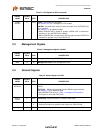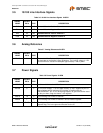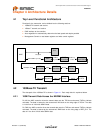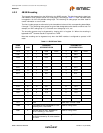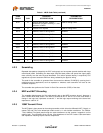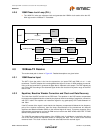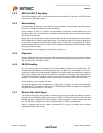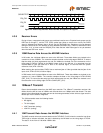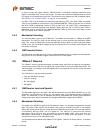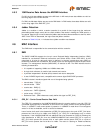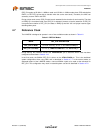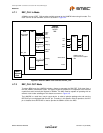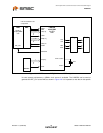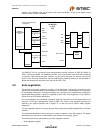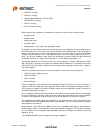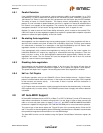
Small Footprint RMII 10/100 Ethernet Transceiver with HP Auto-MDIX Support
Datasheet
Revision 1.0 (05-28-09) 24 SMSC LAN8720/LAN8720i
DATASHEET
In order to comply with legacy 10Base-T MAC/Controllers, in Half-duplex mode the transceiver loops
back the transmitted data, on the receive path. This does not confuse the MAC/Controller since the
COL signal is not asserted during this time. The transceiver also supports the SQE (Heartbeat) signal.
See Section 5.3.2, "Collision Detect," on page 50, for more details.
For RMII, TXD[1:0] shall transition synchronously with respect to REF_CLK. When TXEN is asserted,
TXD[1:0] are accepted for transmission by the LAN8720/LAN8720i. TXD[1:0] shall be “00” to indicate
idle when TXEN is deasserted. Values of TXD[1:0] other than “00” when TXEN is deasserted are
reserved for out-of-band signalling (to be defined). Values other than “00” on TXD[1:0] while TXEN is
deasserted shall be ignored by the LAN8720/LAN8720i.TXD[1:0] shall provide valid data for each
REF_CLK period while TXEN is asserted.
4.4.2 Manchester Encoding
The 4-bit wide data is sent to the TX10M block. The nibbles are converted to a 10Mbps serial NRZI
data stream. The 10M PLL locks onto the external clock or internal oscillator and produces a 20MHz
clock. This is used to Manchester encode the NRZ data stream. When no data is being transmitted
(TXEN is low), the TX10M block outputs Normal Link Pulses (NLPs) to maintain communications with
the remote link partner.
4.4.3 10M Transmit Drivers
The Manchester encoded data is sent to the analog transmitter where it is shaped and filtered before
being driven out as a differential signal across the TXP and TXN outputs.
4.5 10Base-T Receive
The 10Base-T receiver gets the Manchester- encoded analog signal from the cable via the magnetics.
It recovers the receive clock from the signal and uses this clock to recover the NRZI data stream. This
10M serial data is converted to 4-bit data nibbles which are passed to the controller across the MII at
a rate of 2.5MHz.
This 10M receiver uses the following blocks:
Filter and SQUELCH (analog)
10M PLL (analog)
RX 10M (digital)
MII (digital)
4.5.1 10M Receive Input and Squelch
The Manchester signal from the cable is fed into the transceiver (on inputs RXP and RXN) via 1:1 ratio
magnetics. It is first filtered to reduce any out-of-band noise. It then passes through a SQUELCH
circuit. The SQUELCH is a set of amplitude and timing comparators that normally reject differential
voltage levels below 300mV and detect and recognize differential voltages above 585mV.
4.5.2 Manchester Decoding
The output of the SQUELCH goes to the RX10M block where it is validated as Manchester encoded
data. The polarity of the signal is also checked. If the polarity is reversed (local RXP is connected to
RXN of the remote partner and vice versa), then this is identified and corrected. The reversed condition
is indicated by the flag “XPOL“, bit 4 in register 27. The 10M PLL is locked onto the received
Manchester signal and from this, generates the received 20MHz clock. Using this clock, the
Manchester encoded data is extracted and converted to a 10MHz NRZI data stream. It is then
converted from serial to 4-bit wide parallel data.
The RX10M block also detects valid 10Base-T IDLE signals - Normal Link Pulses (NLPs) - to maintain
the link.



